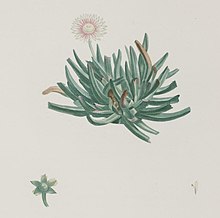| Acrodon bellidiflorus | |
|---|---|

| |
| Scientific classification | |
| Kingdom: | Plantae |
| Clade: | Tracheophytes |
| Clade: | Angiosperms |
| Clade: | Eudicots |
| Order: | Caryophyllales |
| Family: | Aizoaceae |
| Genus: | Acrodon |
| Species: | A. bellidiflorus |
| Binomial name | |
| Acrodon bellidiflorus (L.) N.E.Br. | |
| Synonyms | |
| |
Acrodon bellidiflorus, the common tiptoothfig, is a mesemb species from South Africa.
Description
Acrodon bellidiflorus is a compact succulent perennial plant. It has a woody taproot with fine roots growing off it. This is the only species in its genus where this trait is common
The deep green leaves are triangular. They have a persistent seeth [sic?] that turns black with age. The keel and margins may be smooth or may have three or four flexible teeth with broad bases. The number of teeth may also vary between populations. The eastern populations have short visible internodes. Internodes are not visible in other populations.
The flowers are white or pale pink in colour and have a diameter of about 35 mm (1.4 in). There is only a single flower at the tip of each flowering branch. They are present between April and July.
Distribution and habitat
This species is endemic to South Africa. It is found growing between McGregor and Bredasdorp and the Klein Karoo. It grows in areas that have renosterveld, coastal fynbos or grassland biomes.
Taxonomy
Initially, Acrodon bellidiflorus was the only species in its genus. A closer examination of Ruschia in 1986, however, found that several species shared traits with Acrodon bellidiflorus, resulting in them being moved to the genus Acrodon.
Conservation
This species is considered to be of least concern by the South African National Biodiversity Institute.
References
- "Acrodon bellidiflorus". Global Biodiversity Information Facility. Retrieved 20 January 2023.
- ^ e-Flora of South Africa. v1.36. 2022. South African National Biodiversity Institute. http://ipt.sanbi.org.za/iptsanbi/resource?r=flora_descriptions&v=1.36
- ^ Hartmann, Heidrun E.K.; Niesler, Ingeborg M. (2012). "A Gordion knot in Ruschioideae (Aizoaceae): Acrodon and Brianhuntleya in an attempt to disentangle the confusion". Bradleya. 30 (30): 33–60. doi:10.25223/brad.n30.2012.a8. ISSN 0265-086X.
- ^ Manning, John; Goldblatt, Peter (2012). Plants of the Greater Cape Floristic Region : 1: the core Cape flora (PDF). Pretoria: South African National Biodiversity Institute, SANBI. ISBN 978-1-919976-74-7. OCLC 852384288.
- Glen, H. F. (1986-10-28). "Numerical taxonomic studies in the subtribe Ruschiinae (Mesem-bryanthemaceae) — Astridia, Acrodon and Ebracteola". Bothalia. 16 (2): 203–226. doi:10.4102/abc.v16i2.1088. ISSN 2311-9284.
- Burgoyne, P.M. 2006. Acrodon bellidiflorus (L.) N.E.Br. National Assessment: Red List of South African Plants version 2020.1. Accessed on 20 January 2023
| Taxon identifiers | |
|---|---|
| Acrodon bellidiflorus | |
| Mesembryanthemum bellidiflorum | |